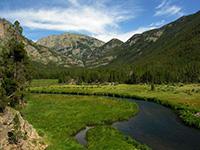50th Anniversary – Congratulations
 Perhaps you’ve fished for Rio Grande Cutthroats in the South San Juan Wilderness, or hiked the Great Sand Dunes Wilderness, or taken a canoe trip in the quiet lakes of the Boundary Waters of Minnesota. At some point as a sportsman and outdoor enthusiast you have enjoyed the benefits of wilderness.
Perhaps you’ve fished for Rio Grande Cutthroats in the South San Juan Wilderness, or hiked the Great Sand Dunes Wilderness, or taken a canoe trip in the quiet lakes of the Boundary Waters of Minnesota. At some point as a sportsman and outdoor enthusiast you have enjoyed the benefits of wilderness.
Wilderness areas provide, bar none, some of greatest, most adventurous hunting and fishing in North America. Today, we celebrate the 50th Anniversary of the signing of the Wilderness Act. Hunters and anglers were a major force behind the law at its signing, and they are a major force for backcountry conservation today.
Not every place can be, or should be, wilderness. In fact, the drafters of the Act defined Wilderness this way: “an area where the earth and its community of life are untrammeled by man, where man himself is a visitor who does not remain” and as “an area of undeveloped Federal land retaining its primeval character and influence without permanent improvements or human habitation, which is protected and managed so as to preserve its natural conditions . . . .”
By some estimates, only 4 percent of the Lower 48 still have “wilderness quality” characteristics. That may be your backyard, or it may be your once-in-a-lifetime dream-come-true adventure.
In 1964, there were fewer than 200 million Americans. Today, there are more than 300 million. All of us put pressure on our remaining wild habitats and clean waters. That is why wilderness areas, and the Wilderness Act, remain relevant after all these decades.
As Andrew McKean wrote in this month’s Outdoor Life: “Whether we would ever visit a wilderness area isn’t really the point. Instead, it’s about the idea that Americans care enough for wild places to create a special category for them, ensuring they remain primitive in nature and generous in adventure for years to come.”
Happy Birthday, America’s Wilderness Act.
